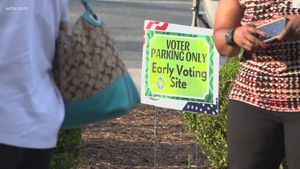Hurricane Ernesto, once a tropical storm impacting Puerto Rico, has morphed through various stages, showcasing the chaotic nature of Atlantic storms. For many living under its grip, the past week has brought a whirlwind of challenges.
Initially forming as a tropical disturbance, Ernesto picked up momentum rapidly, becoming the fifth named storm of the 2024 Atlantic hurricane season. By August 12, it had intensified, raising concerns among residents across the Caribbean.
Ernesto didn’t just brush through Puerto Rico; it left devastating impacts. Over 725,000 residents were left without power as it drenched the island, causing mass disruptions.
On August 15, Ernesto made landfall, unleashing heavy rainfall and strong winds. Puerto Rico's power company, LUMA Energy, reported unprecedented outages and began prioritizing restoration for hospitals and emergency facilities.
The storm's intensity was felt acutely, with widespread flooding causing mudslides. Roads were underwater, and evacuations became the order of the moment.
Further complicity arose as coastal communities braced for rip currents and potential flooding. The hazards made swimming near shore extraordinarily dangerous, leading to multiple rescues.
By the next day, as Ernesto moved north, it was reclassified as a hurricane, this time achieving Category 1 status. Winds reached approximately 75 miles per hour, but forecasters warned the situation was dynamic, with the storm projected to strengthen.
While Puerto Rico bore the brunt, meteorologists had their eyes on the broader forecast. Predictions indicated Ernesto could evolve toward Bermuda, creating chain reactions through weather systems already impacted by previous storms.
The storm's path quickly shifted, causing disruptions across multiple regions. By August 17, Ernesto struck Bermuda, though not with the same force credited to its earlier passage.
Across Bermuda’s shores, locals prepared for the storm’s approach, anxious after having seen its earlier fury over Puerto Rico. Fortunately, Ernesto’s trailing winds were less severe as it began to weaken.
Despite diminishing strength, the cyclone still posed threats like coastal flooding and wave surges. Forecasts warned of waves reaching dangerous heights along the Atlantic Coast.
Ernesto started to lose organization as it moved away from Bermuda and back toward the North Atlantic. By Sunday, August 18, it had reverted back to Category 1 status, exhibiting resilience not often witnessed this far north.
Onlookers noted how the storm closely followed the Gulf Stream’s warm waters. Experts indicated these sustained temperatures have been known to fuel storms, allowing them to linger longer than average.
Newfoundland braced for Ernesto as weather alerts were issued due to anticipated coastal impacts. When it arrived off Newfoundland’s shores, the storm was met with mixed reactions—relief coupled with preparation for heavy surges and rainfall.
By August 19, Newfoundland experienced significant rainfall, leading to swift accumulation on roads and public systems. Emergency services remained on high alert, prepared for flood scenarios.
Residents along the Avalon Peninsula could sense nature's turmoil as they prepared for potential flooding. With warnings surfacing about high surf and coastal flooding, businesses and homes fortified against the incoming tide.
Fortunately for most, the cyclone's path veered off, sparing many communities from direct hit impacts. Railways, boats, and ferries saw disrupted schedules as precautions were implemented.
When Ernesto exited the coastal waters, it departed not without acknowledgment. For Newfoundland, the storm was more of an observer than devastator, with some winds barely touching the shores.
People reflected on Ernesto’s unpredictable nature as it transformed from fierce hurricane to post-tropical storm. By early Tuesday morning, it had dissipated, leaving those along the coast to process the storm's brief but impactful stay.
For many, the immediate focus turned to recovery and rebuilding. With memories fresh of stockpiling supplies and securing property, residents began cleanup efforts.
Though the experiences associated with Hurricane Ernesto will linger, so too will the lessons learned from its unpredictable path. The Atlantic's chaotic dance of storms continues, leaving communities to adapt and prepare.
Temperature patterns observed by meteorologists indicate more storms may soon develop. The remnants of such formations may circle back, stirring fear and resilience simultaneously with each season.
Overall, Ernesto’s legacy as not just another storm but as a reminder of nature's unpredictability remains vivid. Communities along the Atlantic look forward, ready to face whatever may come next.
With overall safety advised, the takeaway remains: always respect the warnings of nature, for she is ever-changing.



